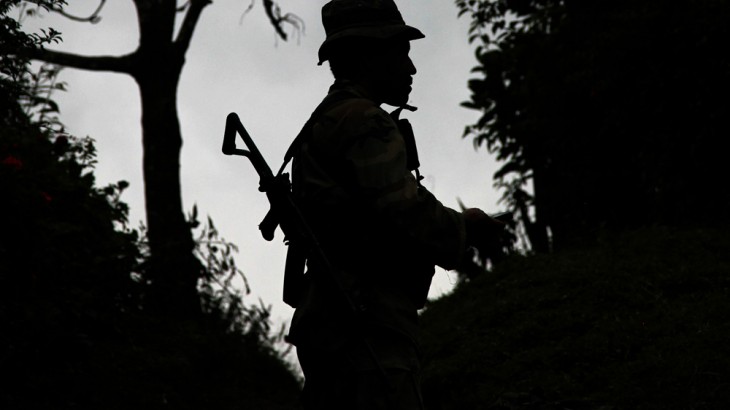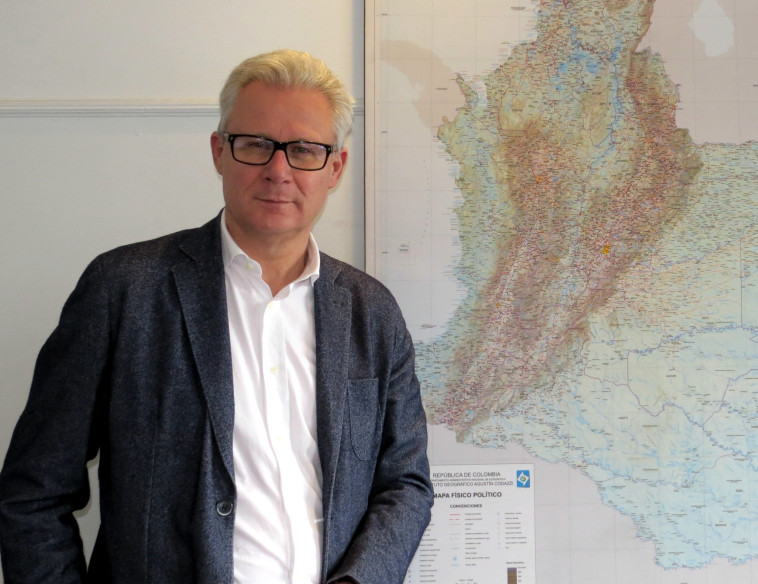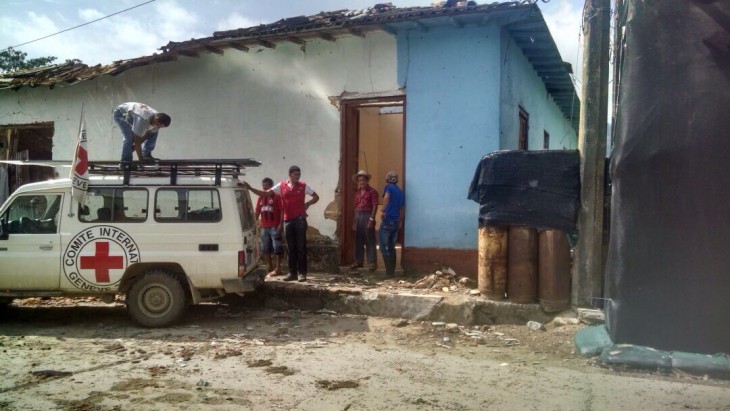Head of the International Committee of the Red Cross in the country talks about the ups and downs: “History has shown that you have to ask what’s the price of continuing the conflict. That’s the question the Israelis and Palestinians should ask, too.”
An article by Haim Isarovitz, published in ‘Maariv’ on 9 December 2016
The End to Arms: The Path to Peace in Colombia After 52 Years of Violence
For the residents of the city of Ifilis, located in southwestern Colombia not far from the border with Ecuador, the many years of war between the army and the militants of the Marxist guerilla organization FARC (“the Revolutionary Armed Forces of Colombia”) produced a difficult, violent situation that included explosions, kidnappings, shooting attacks and drug smuggling. Almost everyone who lived in the city feels the violent side of the conflict, like 12-year-old John, who spoke about the moment his brother was murdered. “It was six in the evening, and my brother, who was 16, went out to play with our brothers and sisters in the street,” he recalled. “A motorcycle passed by with two mercenaries on it; they shot him twice. It is very painful. When I think about it, I cry.”
John’s painful story appears in the book, Children Think About Peace, which includes stories, thoughts and pictures by children from throughout Colombia, collected as part of a widespread project in 2014 with the objective and giving voice to the views of the younger generation regarding the harsh civil war, which has taken the lives of 220,000 people and left more than 6 million uprooted, and about the peace process between the government and the underground that began in Cuba four years ago.
John has a clear message for the representatives of FARC who sat at the peace talks in Havana. “The time has come to make peace after 50 years of violence, massacre and deaths,” the young boy wrote. “They need to leave their weapons and disarm so that there won’t be any conflicts any more. And the president also has to stop buying weapons for the army in order to confront the guerrillas and have more families lose their loved ones, so that there won’t be any more pain.”
Two years later, is seemed that the hope for peace and a better future expressed by John and many of the children who participated in the project is closer than ever to becoming a reality. The two sides reached an historic peace agreement meant to conclude the 52 years of the longest armed conflict in Latin America. “We will achieve every goal, overcome every obstacle and turn the nation into the country we always dreamed of – a country that lives in peace,” declared the president of Colombia, Juan Manuel Santos, at the festive signing ceremony held in the city of Cartagena in late September, with the participation of senior representatives from throughout the world.
There were quite a few snags on the way to signing the new agreement. A few days after the ceremony in Cartagena, a referendum was held, and amazingly, the camp that opposed the wording of the agreement, led by the former president, Alvaro Uribe, won with 50.2% of the vote. “We were all very surprised. None of those involved in the negotiations or those who followed it expected the result. It was a heavy blow,” says Christoph Harnisch, head of the office of the International Committee of the Red Cross in Colombia, in a conversation with Maariv-Weekend in his office in Bogota. “But we had to admit that in light of the length of the conflict, which often included the use of very violent means, doubts arose among many residents whether ending the conflict in negotiations was really the right way.”
Despite the surprising results, both parties made it clear that they are still committed to the process and Santos began consultations with representatives of the different sectors, including his political opponents, to hear ideas and suggestions for resolving the issues of contention, primarily the exhaustion of legal remedies for those who committed war crimes against humanity during the conflict and the inclusion of FARC members in the political arena.
About two weeks ago the new agreement was signed in Havana, but this time Santos took no risks and had the new wording– which he claims includes the reservations that arose during the talks after the referendum – passed in both houses of parliament where it has a solid majority. The opposition, which protested the swift process and circumvention of the voters, boycotted the vote, and the agreement was approved in late November by a wide majority – without opponents.
Harnisch admits that the test lies in swift and genuine implementation of the agreement, among other things in order to prevent the opposition from changing it if they come into power. “If there is a controversial agreement, those with doubts will continue to be skeptical, and therefore it’s important that the guerillas begin a process according to the agreement and towards integration into society,” he says. “There are many challenges, but both sides are demonstrating a clear desire for it to work.” He adds that the intervention of the UN, which is supervising the implementation of the clauses, and primarily the disarmament, is contributing to giving everyone in Colombia guarantees that all is being done according to the agreement.
Speaking with the Guerilla
Tomorrow, as every year on the 10th of December, the festive ceremonies of the Nobel Prize will be held. Most of the attention will be directed at Oslo City Hall, where President Santos of Colombia will receive the Nobel Peace Prize for 2016 in the presence of the King of Norway, Harald V. When the prize committee declared Santos as winner of the prize, just five days after he had lost the referendum, it noted that he was being honored with the prestigious award “for his persistent efforts to bring the civil war to an end.”
Harnisch notes that in Colombia nobody wondered why the prize was awarded only to Santos and not shared between him and head of the underground, Rodrigo Londoño (“Timochenko”), who was a full partner in the peace process. “It was recognized that when Santos came into power in 2010, he made the important decision to identify the problem correctly,” he explains.
“The position of his predecessor, Uribe, was that this was an armed conflict between a government and a terror organization, but Santos understood that it was an internal conflict within the country. He made contact with the guerilla organization and from the start was committed to achieving an accord. In FARC they also said that he did what no other president before him did and continued the talks even in difficult times.”
The Red Cross played an active role in Colombia throughout the years of the civil war, among other things, by aiding the injured and displaced citizens, visiting prisoners in jail, finding missing persons and in deals to free kidnapped persons from the guerilla organization. Therefore, when the peace process between the Santos government and FARC began in 2012, it was only natural that the international aid organization – which has been awarded the Nobel Peace Prize three times in the past – would also have a role in ending the conflict.
According to Harnisch, he and his staff dealt with the humanitarian aspects of the agreement being developed and the means to implement them, and because of the organization’s neutrality and methods, which were based on discretion and trust, close relations were built with both sides. Among other things, he says that they discussed ways to resolve the issue of people who disappeared over the years of the conflict and how to update the family members about finding bodies, ways to remove the mines and roadside explosives that are still dispersed in the areas of fighting and could continue to take lives and how to return the young people who fought in the ranks of FARC to their families and reintegrate them into society. “We will continue to deal with these issues in the framework of implementing the agreement, but it will be necessary for all sides to participate in order to succeed,” he said.
The most complex issue in the negotiations had to do with setting up a legal mechanism to bring to justice those from both opposing sides who committed crimes against humanity and war crimes during the years of conflict. “There were some who wondered whether it was possible to negotiate with someone who knows he will go to prison afterwards,” Harnisch said.
In the end, it was decided that a new legal authority would be set up, in which people who were involved in the fighting could admit their involvement in serious crimes in return for relatively lighter sentences. Those who refused to admit responsibility for crimes and are found to have lied in their confessions will be subject to very severe legal measures. In addition, it was decided that property that belonged to FARC would be confiscated for the purpose of paying compensation to the victims. “As soon as agreement on this was achieved, the way to the overall peace agreement was simpler,” Harnisch explains.
Now that the agreement has already been approved by the congress, both parties need to start with practical implementation. To begin with, thousands of members of FARC will have to convene in special camps where they will give up their arms in the coming months and they will begin a process of reintegration into society and establishment of a new political party that is expected already to run in the next elections.
“The commitment of both parties is total. They are committed to what was agreed,” says Harnisch, who emphasizes that in order for the implementation of the agreement to succeed, it is necessary to recruit all parts of the country.
“This may be an excellent agreement, but if it doesn’t reach complete fulfillment in the areas that suffered the hardest, the conflict won’t really be resolved.” He noted that “first of all, the fighting has to stop, followed by building a new society that will be more egalitarian, with a better legal system and supervision of drug trade. This will require a lot of time and there is a strong commitment, although we mustn’t forget that a tremendous, concerted, intellectual effort must be made in the coming years, as well. It’s not only commitment of those who are not in power, but it has to continue for generations to come, as well.”
The Overall Costs
As part of his long career in the Red Cross, which began in 1984, Harnisch also came to know another area of conflict – between Israel and the Palestinians. In May 198, he was appointed head of the office in the Gaza Strip, and between 2006 and 2008 he ran the office of the Red Cross in Israel and the Palestinian Territories. He notes that the hardest moments during his time in the area were the difficulty in providing humanitarian aid in the Gaza Strip area because of the tension between the parties. “In every conflict, however terrible and however violent, if there is no humane, humanitarian dimension, as the Red Cross tries to carry out, there is a population without protection, and the civilians are the ones who lose,” he says. “The difficulty on both sides to respect the human aspect was the most difficult thing.”
Harnisch says that the Colombian negotiating teams consulted with experts who had participated in similar processes around the world, such as former minister of foreign affairs, Professor Shlomo Ben Ami, who talked about the process with the Palestinians, or members who were involved in resolving the conflict in Northern Ireland, but ultimately “they didn’t want to import solutions, but wanted an agreement that was unique to the Colombian case.”
Even though he admits that he has not been involved in the Israel-Palestinian conflict since 2009, and that today he focuses only on promoting the agreement in Colombia, Harnisch also has insights that might be important to what is happening in this region. “The important moment in the conflict was when the Colombians thought about the cost of continuing the military tension, which clearly would not succeed in totally destroying this guerillas group, and the likely cost of the agreement. They reached the conclusion that the cost of the military tension was too high for the society as a whole and that an organized peace agreement was needed,” Harnisch says. “This is a controversial choice, but history has shown that the question about the cost to society must be asked. It’s a fundamental question, and Israel and the Palestinians have to ask it, too.”
When he looks at his three decades in the ranks of the Red Cross, Harnisch admits that the situation today is worrying. “In my first days, the staff of the Red Cross were respected and there was recognition of the role they played and understanding that they did not fulfill a political role, that they had no hidden agenda,” he says. “But since the 1990s this has changed, because there are many more humanitarian organizations, of the UN and of NGOs, and this has created a problem of coordinating the humanitarian effort and sometimes also of misinterpretation of the humanitarian task.”
The work, he adds, is now more complex than in the past. “It’s challenging work in a world that has less respect for the humanitarian aspect. It’s a distressing development,” he notes sadly. The more violent the wars, the more difficult to end them. I don’t have much hope when I see what’s happening in the Middle East, or in Latin America, where there are still many challenges.”




